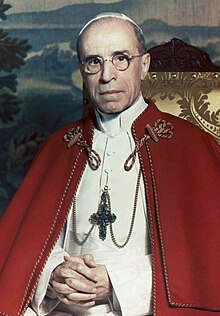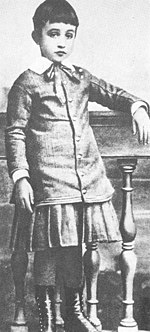
A | B | C | D | E | F | G | H | CH | I | J | K | L | M | N | O | P | Q | R | S | T | U | V | W | X | Y | Z | 0 | 1 | 2 | 3 | 4 | 5 | 6 | 7 | 8 | 9
Pius XII | |
|---|---|
| Bishop of Rome | |
 Pius XII c. 1951 | |
| Church | Catholic Church |
| Papacy began | 2 March 1939 |
| Papacy ended | 9 October 1958 |
| Predecessor | Pius XI |
| Successor | John XXIII |
| Orders | |
| Ordination | 2 April 1899 by Francesco di Paola Cassetta |
| Consecration | 13 May 1917 by Pope Benedict XV |
| Created cardinal | 16 December 1929 by Pope Pius XI |
| Personal details | |
| Born | Eugenio Maria Giuseppe Giovanni Pacelli 2 March 1876 |
| Died | 9 October 1958 (aged 82) Castel Gandolfo, Lazio, Italy |
| Previous post(s) |
|
| Education | |
| Motto | Opus Justitiae Pax ("The work of justice peace" ) |
| Signature |  |
| Coat of arms |  |
| Sainthood | |
| Venerated in | Catholic Church |
| Title as Saint | Venerable |
| Other popes named Pius | |
Ordination history of Pope Pius XII | |||||||||||||||||||||||||
|---|---|---|---|---|---|---|---|---|---|---|---|---|---|---|---|---|---|---|---|---|---|---|---|---|---|
| |||||||||||||||||||||||||
| |||||||||||||||||||||||||
Pope Pius XII (born Eugenio Maria Giuseppe Giovanni Pacelli, Italian pronunciation: [euˈdʒɛːnjo maˈriːa dʒuˈzɛppe dʒoˈvanni paˈtʃɛlli]; 2 March 1876 – 9 October 1958) was head of the Catholic Church and sovereign of the Vatican City State from 2 March 1939 until his death in October 1958. Before his election to the papacy, he served as secretary of the Department of Extraordinary Ecclesiastical Affairs, papal nuncio to Germany, and Cardinal Secretary of State, in which capacity he worked to conclude treaties with various European and Latin American nations, including the Reichskonkordat treaty with the German Reich.[1]
While the Vatican was officially neutral during World War II, the Reichskonkordat and his leadership of the Catholic Church during the war remain the subject of controversy—including allegations of public silence and inaction concerning the fate of the Jews.[2] Pius employed diplomacy to aid the victims of the Nazis during the war and, through directing the church to provide discreet aid to Jews and others, saved hundreds of thousands of lives.[3][4] Pius maintained links to the German resistance, and shared intelligence with the Allies. His strongest public condemnation of genocide was considered inadequate by the Allied Powers, while the Nazis viewed him as an Allied sympathizer who had dishonoured his policy of Vatican neutrality.[5]
During his papacy, the Catholic Church issued the Decree against Communism, declaring that Catholics who profess communist doctrine are to be excommunicated as apostates from the Christian faith. The church experienced severe persecution and mass deportations of Catholic clergy in the Eastern Bloc. He explicitly invoked ex cathedra papal infallibility with the dogma of the Assumption of Mary in his Apostolic constitution Munificentissimus Deus.[6] His forty-one encyclicals include Mystici Corporis Christi, on the Church as the Mystical Body of Christ; Mediator Dei on liturgy reform; and Humani generis, in which he instructed theologians to adhere to episcopal teaching and allowed that the human body might have evolved from earlier forms. He eliminated the Italian majority in the College of Cardinals in 1946.
After he died in 1958, Pope Pius XII was succeeded by John XXIII. In the process toward sainthood, his cause for canonization was opened on 18 November 1965 by Paul VI during the final session of the Second Vatican Council. He was made a Servant of God by John Paul II in 1990 and Benedict XVI declared Pius XII Venerable on 19 December 2009.[7]
Early life

Eugenio Maria Giuseppe Giovanni Pacelli was born on the second day of Lent, 2 March 1876, in Rome into a family of intense Catholic piety with a history of ties to the papacy (the "Black Nobility"). His parents were Filippo Pacelli (1837–1916) and Virginia (née Graziosi) Pacelli (1844–1920). His grandfather Marcantonio Pacelli had been Under-Secretary in the Papal Ministry of Finances[8] and then Secretary of the Interior under Pope Pius IX from 1851 to 1870 and helped found the Vatican's newspaper, L'Osservatore Romano in 1861.[9][10] His cousin, Ernesto Pacelli, was a key financial advisor to Pope Leo XIII; his father, Filippo Pacelli, a Franciscan tertiary,[11] was the dean of the Roman Rota; and his brother, Francesco Pacelli, became a lay canon lawyer and the legal advisor to Pope Pius XI, in which role he negotiated the Lateran Treaty in 1929 with Benito Mussolini, bringing an end to the Roman Question.
Together with his brother Francesco (1872–1935) and his two sisters, Giuseppina (1874–1955) and Elisabetta (1880–1970),[12] he grew up in the Parione district in the centre of Rome. Soon after the family had moved to Via Vetrina in 1880, he began school at the convent of the French Sisters of Divine Providence in the Piazza Fiammetta. The family worshipped at Chiesa Nuova. Eugenio and the other children made their First Communion at this church and Eugenio served there as an altar boy from 1886. In 1886 too he was sent to the private school of Professor Giuseppe Marchi, close to the Piazza Venezia.[13] In 1891 Pacelli's father sent Eugenio to the Ennio Quirino Visconti Liceo Ginnasio, a state school situated in what had been the Collegio Romano, the premier Jesuit university in Rome.
Zdroj:https://en.wikipedia.org?pojem=Pope_Pius_XII
Text je dostupný za podmienok Creative Commons Attribution/Share-Alike License 3.0 Unported; prípadne za ďalších podmienok. Podrobnejšie informácie nájdete na stránke Podmienky použitia.
Antropológia
Aplikované vedy
Bibliometria
Dejiny vedy
Encyklopédie
Filozofia vedy
Forenzné vedy
Humanitné vedy
Knižničná veda
Kryogenika
Kryptológia
Kulturológia
Literárna veda
Medzidisciplinárne oblasti
Metódy kvantitatívnej analýzy
Metavedy
Metodika
Text je dostupný za podmienok Creative
Commons Attribution/Share-Alike License 3.0 Unported; prípadne za ďalších
podmienok.
Podrobnejšie informácie nájdete na stránke Podmienky
použitia.
www.astronomia.sk | www.biologia.sk | www.botanika.sk | www.dejiny.sk | www.economy.sk | www.elektrotechnika.sk | www.estetika.sk | www.farmakologia.sk | www.filozofia.sk | Fyzika | www.futurologia.sk | www.genetika.sk | www.chemia.sk | www.lingvistika.sk | www.politologia.sk | www.psychologia.sk | www.sexuologia.sk | www.sociologia.sk | www.veda.sk I www.zoologia.sk
